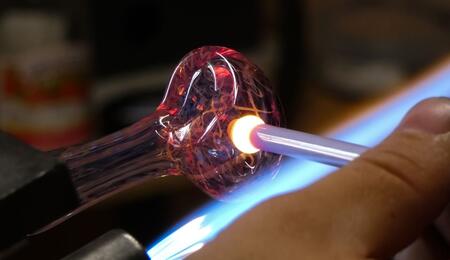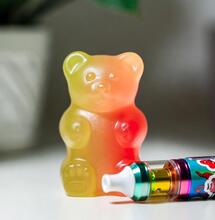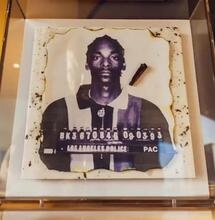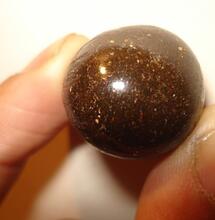Borosilicate Lamp-Working

Smoking pipes are often made of borosilicate glass (abbreviated to 'boro') and crafted by a 'lamp-worker'. Colors and other embellishments can be added to personalize your smoking gear. The art of making unique, stylish pipes and other smoking gear is not a simple one. But here's a basic how-to-guide to get some insights into the artisan process.
One of the simplest types of these pipes are known as 'spoons' in reference to their shape, which in some cases resembles a cooking spoon, the cheapest of which are pretty inexpensive. On the other hand, some of the more elaborate water pipes and oil rigs can cost thousands of dollars. The high initial equipment cost, perceived danger involved and the prevalence of cheap imported pipes in the market can be a hindrance to those seeking to learn the craft, but it can still be done and is one of the few places left where craftsman/artisan-style folks can still earn a living.
Borosilicate glass has had boric oxide added to the silica during manufacturing to impart better thermal tolerance. The coefficient of thermal expansion (CTE) of borosilicate glass is much lower than that of most other types of glass, making it less prone to breakage from changes in temperature - a handy attribute for smoking pipes. It is a material commonly used for scientific purposes and is normally employed to make test tubes, beakers and other laboratory glassware. Colored glass rods are often melted and added to the clear glass to add flair and style. Rough, sand-sized bits of colored glass called 'frit' can be applied and melted in for a simple, yet interesting, effect. Care must be taken when using un-melted frit, as the small particles can be a breathing hazard.
Metal is sometimes fumed onto a pipe to create color-changing glass
The colored glass utilized is more expensive than the clear glass, so it is typically used more sparingly. Skillful application and use of color is a large part of the artistry in lamp-working: stripes, wig-wags, stacked dots, twisted canes and other methods are used to make interesting effects with colors. Secrets of how effects are created are sometimes shared, and sometimes kept, and learning how they are made is a combination of instruction and trial-and-error. Small bits of silver or gold are sometimes heated until they give off a fume, which is collected on the glass to impart color (often used to make 'color-changing' pipes).
Lamp-working requires the artist to work with very hot materials and an open flame, so there is an inherent danger of being burned. This process should not be attempted lightly or without education. It is also not a cheap hobby to get into, with the torch and the kiln constituting two major expenses.
The torch uses a combination of propane and oxygen to create a flame. Although temperatures are still very hot (approximately 4,500º F or 2,400º C), working with them they are noticeably cooler than an oxygen/acetylene torch (approximately 6,500º F or 3,600º C). So, at those temperatures, you cannot notice much past 'very, very hot'. The borosilicate glass melts with a much more gentle flow than metal tends to. While in use, the torch is mounted to a bench and faces away from the artist, allowing them to stick objects into the flame while the artisan avoids most of the heat.
Lamp-working torches should be approached with both caution and respect
As the glass heats up it will begin to glow; the combination of the glowing glass and the light from the flame is intense enough to damage unprotected eyes, so glasses with special lenses are used. Even while observing someone else lamp-working, these protective glasses must be used in order to prevent eye damage from the light.
There are many ways to make a spoon pipe, but the most common method is to start with a glass tube. Much of the work is done by heating, melting and manipulating the glass tube without the need for tools, other than a glass rod known as a 'punty'. When tools are required, they are usually made of one of two materials. One is graphite (for actions such as pressing in a bowl), which is very smooth and does not tend to stick to glass - unless it gets too hot. The other option is various types of metal, such as brass, steel or tungsten (for things like holding or shaping the hot glass).
How to Make a Simple Smoking Pipe?
One way to make a very simple spoon pipe is to start with a tube and heat and close one end. Heat the sealed end, then blow gently to create the head of the pipe. Blow a hole through the side of the head and use a graphite rod to press a bowl around the hole. Blow a carburetor, if desired. Melt the pipe off of the rod and work the mouthpiece. Other methods involve forming the mouthpiece first, or adding embellishments and color.
Once the pipe has been finished it is annealed in a kiln, which lowers internal stresses, reducing the likelihood of it cracking or breaking. Any pipes intended for sale should be properly annealed.
Is it a challenge to craft a smoking pipe, even just for the fun of it? You can imagine that even learning the basics is time-consuming process. Also, supplying the materials for work can be pretty costly. Glass working is something that requires a lot of practice. You can log a hundred hours of so behind the torch and still have the feeling that you're just getting started with the learning process. Certainly, it may take years to hone the skill and be able to craft a high-quality smoking pipe. There are many years-worth of things to learn about making more artistic and more elaborate smoking devices.
Also read on Soft Secrets:
- The Bong Appétit Cannabis Cookbook

.jpg)












